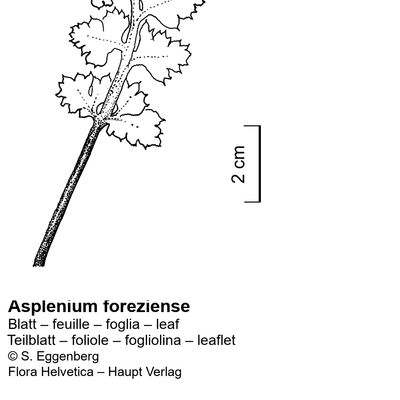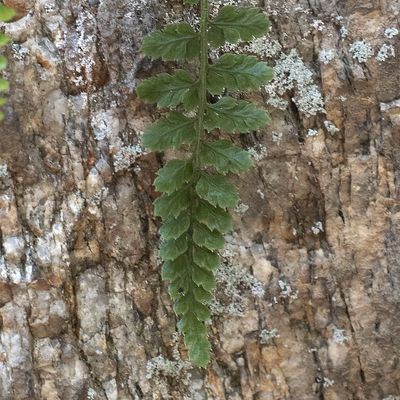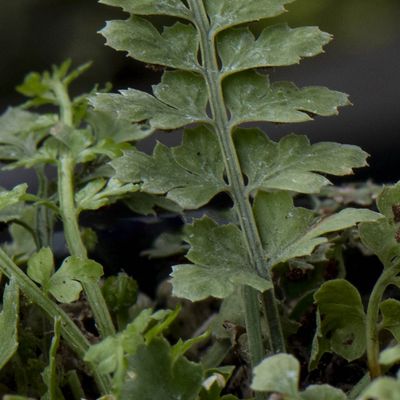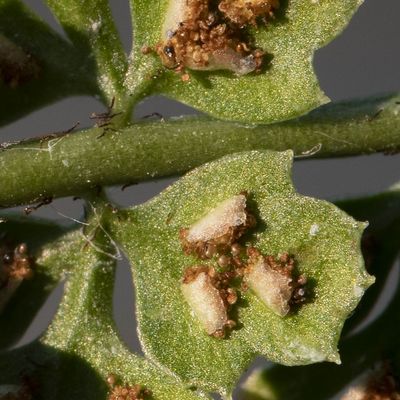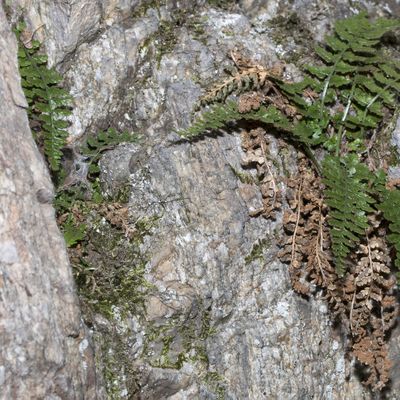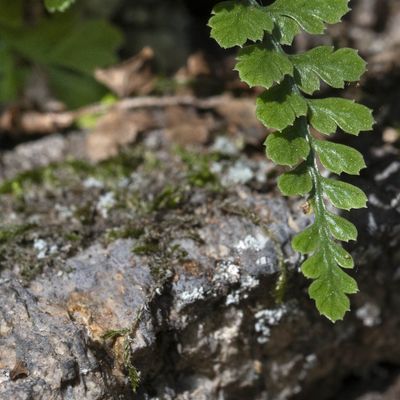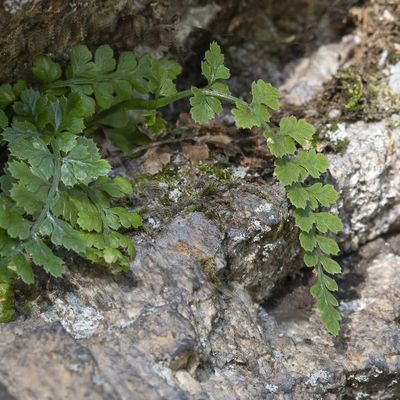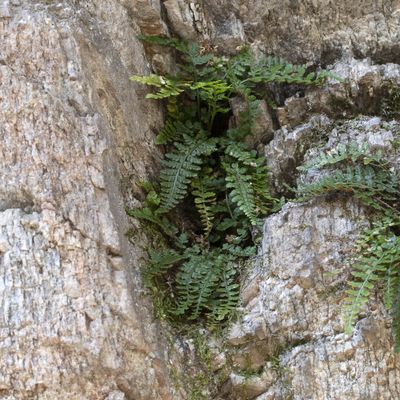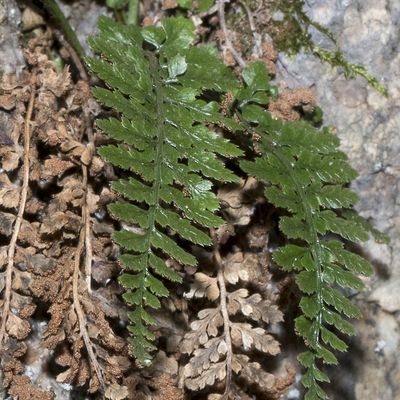Asplenium foreziense Magnier
1005450
Species
ISFS : 50600
Checklist : 1005450
ISFS : 50600
Checklist : 1005450
Contains :
Synthesis
Species description (© Flora Helvetica 2018)
Ähnlich wie A. fontanum, aber Blätter überwinternd, Blattspreite nach unten nur wenig verschmälert (unterste Fiederchen noch 7-14 mm lang), Fiederchen (Abschnitte letzter Ordnung) rundlich, Zähne mit aufgesetzter Spitze, Blattstiel meist mindestens halb so lang wie die Spreite, bis über die Mitte braun oder rotbraun.Flowering period (© Flora Helvetica 2018)
6-9Habitat and distribution inside Switzerland (© Flora Helvetica 2018)
Felsen und Mauern, auf Silikat / kollin-montan / TI (Brissago), VS (Fully ?)World distribution (© Flora Helvetica 2018)
WestmediterranEcological indicator (© Landolt & al. 2010)
222-442.h.2n=144Status
IUCN status
EndangeredNational Priority
2 - high national priorityInternational responsibility
2 - mediumConservation
Threats
Überbauung, Zerstörung der letzten mörtelfreien Trockenmauern, Umwandlung von Trocken- in Mörtel- und Betonmauern
Zerfall der Trockenmauern
Verbuschung, Beschattung der Geröllhalde (VS)
Verunkrautung, Überwucherung durch Konkurrenzpflanzen (Efeu, Brombeeren u.a.)
Intensivierung oder Aufgabe der Rebnutzung (potentielle Fundstellen)
Sammeln, Zerstörung durch Nachlässigkeit
Wenige, isolierte Populationen
Distribution map
Habitat and distribution inside Switzerland
TI (Brissago), VS (Fully ?)World distribution
WestmediterranEcology
Life form
Perennial hemicryptophyte
Habitats
Milieux Phytosuisse (© Prunier et al. 2017)
Habitats © Delarze & al. 2015
 | 3.4.2.2 - Silikatfelsflur (Androsacion vandellii) |
bold
Dominant species, influencing the appearance of the habitat
 Character species
Character species
 Less strictly linked to a specific habitat
Less strictly linked to a specific habitat
Ecological indicator values by © Landolt & al. (2010)
| Soil factors | Climatic factors | Salinity tolerance | |||
|---|---|---|---|---|---|
| Humidity Value H | 2 | Light Value L | 4 | Salinity Index | -- |
| Reaction Value R | 2 | Temperature factor T | 4 | ||
| Nutriments value N | 2 | Continentality K | 2 | ||
- Ecological values legend
Humidity Value H 1 very dry 1+ dry 2 moderatly dry 2+ moist 3 medium wet 3+ wet 4 very wet 4+ soggy 5 submerged or underwater f plants living in running water u mostly submerged plants v partly submerged, partly floating plants w humidity moderately variable (± scale of 1-2) w+ highly variable humidity (scale exceeding ± 2) Reaction Value R 1 Very acid (pH 2.5-5.5) 2 acid (pH 3.5-6.5) 3 lightly acid to neutral (pH 4.5-7.5) 4 neutral to basic (pH 5.5-8.5) 5 basic (pH 6-5 -> 8.5 Nutriments value N 1 very low in nutrients 2 low in nutriments 3 medium-poor to medium-rich in nutrients 4 rich in nutriments 5 very rich in nutriments Salinity tolerance 1 halotolerant 3 halophyle Light Value L 1 very shady 2 shady 3 lighted areas 4 luminous 5 highly luminous Temperature factor T 1 alpine to nival stages (from the treeline to the snowline) 1+ suprasubalpine and upper subalpine levels (pine and larch forests) 2 subalpine level (coniferous forests without beeches up to the upper limit of spruces) 2+ lower subalpine and upper mountain stages 3 mountain level (beech and silver fir forests, in the central Alps Scots pine forests) 3+ lower mountain and upper hill levels 4 hill level (mixed deciduous oak forests) 4+ hot places, hill level 5 very hot places, hill level (only in the hottest places, typical of southern Europe) Continentality K 1 Atlantic (high air humidity, very low temperature variations, mild winters) 2 Sub-Atlantic (high air humidity, low temperature variations, relatively mild winters) 3 sub-Atlantic to subcontinental (average air humidity, moderately variable temperature, slightly low winter temperatures) 4 subcontinental (low air humidity, large temperature variations, rather cold winters) 5 continental (very low air humidity, very large temperature variations, cold winters)
Water dependency
| Rivers | 0 - No link |
| Calm water | 0 - No link |
| Ground water | 0 - No link |
Nomenclature
Accepted Name (Checklist 2017)
Asplenium foreziense Magnier
Vernacular name
Deutscher Name :
Foreser Streifenfarn, Französischer StreifenfarnNom français :
Capillaire du ForezNome italiano :
Asplenio foresiacoMatch with other reference books
| Relation | Nom | Book | No |
|---|---|---|---|
| = | Asplenium foreziense Magnier | Checklist 2017 | 50600 |
| = | Asplenium foreziense Magnier | Flora Helvetica 2001 | 74 |
| = | Asplenium foreziense Magnier | Flora Helvetica 2012 | 47 |
| = | Asplenium foreziense Magnier | Flora Helvetica 2018 | 47 |
| = | Asplenium foreziense Magnier | Index synonymique 1996 | 50600 |
| = | Asplenium foreziense Magnier | Landolt 1977 | 46 |
| = | Asplenium foreziense Magnier | Landolt 1991 | 43 |
| = | Asplenium foreziense Magnier | SISF/ISFS 2 | 50600 |
| = | Asplenium foreziense Magnier | Welten & Sutter 1982 | 44 |
= The taxon corresponds to the accepted taxon (Checklist 2017)
< The taxon is included in the accepted taxon (Checklist 2017)
> The taxon includes (among others) also the accepted taxon (Checklist 2017)
< The taxon is included in the accepted taxon (Checklist 2017)
> The taxon includes (among others) also the accepted taxon (Checklist 2017)
Status
Native status
-IUCN list of endangered species (© Walter & Gillett 1997) : No
Status on national Red List 2016
IUCN status:
Endangered

Additional information
IUCN criteria: B2ab(iii)
Status on regional Red List 2019
| Biogregraphic regions | Status | IUCN criteria |
|---|---|---|
| Jura (JU) | -- | |
| Mittelland (MP) | -- | |
| Alpennordflanke (NA) | -- | |
| Alpensüdflanke (SA) | EN | B2ab(iii) |
| Östliche Zentralalpen (EA) | -- | |
| Westliche Zentralalpen (WA) | -- |
- Legend
EX Extinct RE Regionally Extinct CR(PE) Critically Endangered, Probably Extinct CR Critically Endangered EN Endangered VU Vulnerable NT Near Threatened LC Least Concern DD Data Deficient NE Not Evaluated NA Not Applicable
National Priority Species List Status
| National Priority | 2 - high national priority |
| Need to take action | 2 - |
| International responsibility | 2 - medium |
| Need to monitor populations | 1 - |
Protection status
| International (Bern Convention) | No | |
| TI | total protection | (23.01.2013) |
| Switzerland | -- |
- Disclaimer
InfoFlora compiles information on protected species as accurately as possible, taking it from the respective cantonal laws. In some cases, however, it was not possible to use the plant names as listed in the original text, but an interpretation of their taxonomy or nomenclature was necessary. The exact meaning of the categories „completely protected“ and „partially protected“ differs among the cantons.
InfoFlora cannot guarantee that the information on the protection status is correct and complete. In case of doubts, we recommend to look up the texts of the respective cantonal law.
Status by sector of activity
| Agriculture-related environmental objectives : | more informations | |
| Forest management environmental objectives : | Z - | more informations |
Conservation
Threats and measures
Überbauung, Zerstörung der letzten mörtelfreien Trockenmauern, Umwandlung von Trocken- in Mörtel- und Betonmauern
Schutz und Erhaltung aller noch bestehenden Trockenmauern
Renaturierung von vermörtelten Mauern, Neuschaffung von Silikat-Trockenmauern
Zerfall der Trockenmauern
Schonende Pflege sowie regelmässige Instandsetzung der Trockenmauern (ohne Mörtel!)
Verbuschung, Beschattung der Geröllhalde (VS)
Falls nötig entbuschen und auslichten
Verunkrautung, Überwucherung durch Konkurrenzpflanzen (Efeu, Brombeeren u.a.)
Entfernen der unmittelbaren Konkurrenzpflanzen an den bestehenden Fundstellen
Intensivierung oder Aufgabe der Rebnutzung (potentielle Fundstellen)
Kein Herbizideinsatz am Rand der Rebberge
Erhaltung der bestehenden Rebflächen
Sammeln, Zerstörung durch Nachlässigkeit
Orientierung der Gemeinden und Besitzer
keine öffentliche Bekanntgabe der Fundstellen
Wenige, isolierte Populationen
Schutz (Mikroreservate) und regelmässige Bestandeskontrollen, Dauerflächen-Beobachtung
zytogenetische Untersuchung der Population im Wallis
Erfolgskontrollen der Massnahmen gewährleisten

